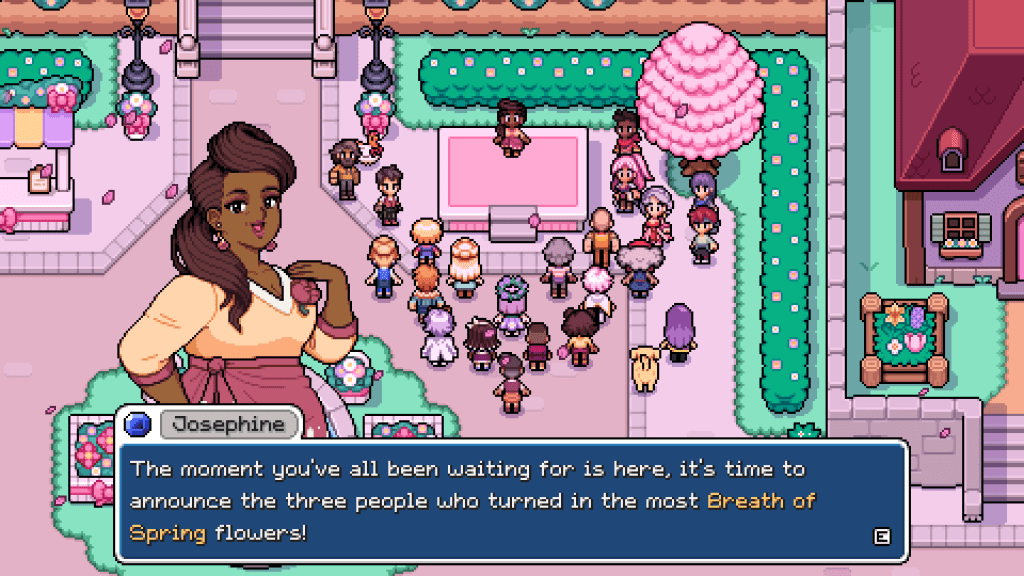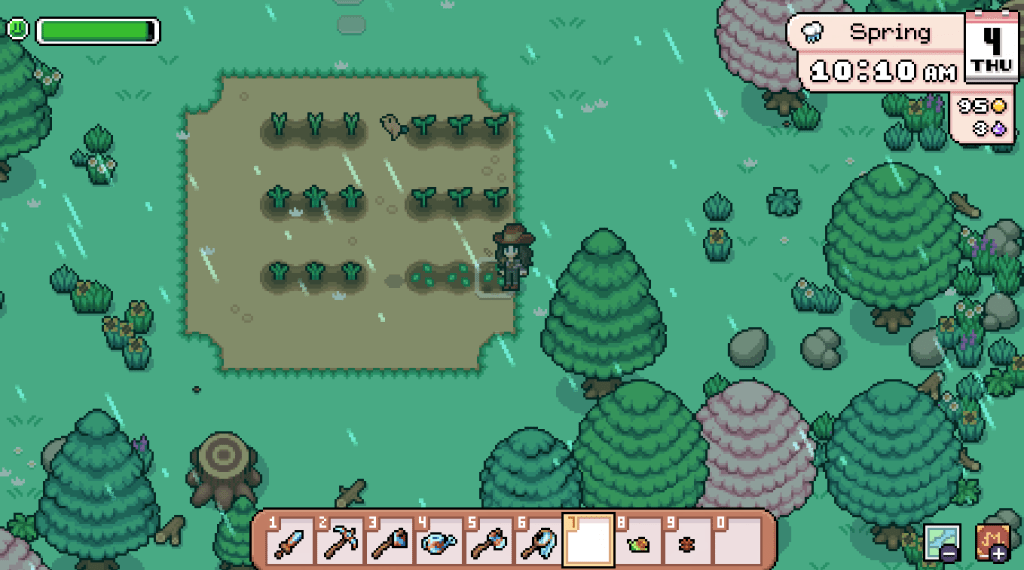A quaint town sits nestled among mountains and green hills. Colorful birds flit from tree to tree, and fish swim up rivers of sapphire blue water. The citizens of Mistria go about their days, wandering from shop to shop, each a colorful character in their own right. And while Fields of Mistria may look like your run-of-the-mill farming simulator, it seems to be much, much more than that.
The genre Fields of Mistria occupies is undoubtedly one of my favorite in games. I became enchanted with the Harvest Moon series through Harvest Moon: A Wonderful Life as a child, and dabbled in the likes of Stardew Valley, Rune Factory, Palia, and more. When Fields of Mistria crossed my radar a few years ago, I was immediately intrigued, even if it was just a few bits of character artwork here and there. Because while these games are functionally the same in their mechanics, nothing quite looks like Fields of Mistria.

The sprite work for the characters is deliciously detailed and remind me of when I used to comb through Yuu Watase manga like Imadoki! or Alice 19th. It has that mid-90’s to early 2000’s appeal, and isn’t afraid to wear these inspirations on its sleeve. Juniper, the resident bathhouse owner, who’s laugh is a direct reference to a popular trope, that you’d see in a series like Sailor Moon or other popular shoujo manga and anime of that time. Fields of Mistria seems to embrace these aesthetics and weave them into the game, with characters fulfilling specific archetypes. And because it doesn’t shy away from that, it makes Fields of Mistria all the stronger.
You more or less know what you’re going to get with each character, as their personalities generally correspond with their looks. At least based on what I experienced. And there isn’t anything wrong with that. These “anime” archetypes exist for a reason, and are popular. Olric is a part-time shop assistant, which is evident by his character portrait, whereas March the blacksmith immediately reads as standoffish with his tilted head and frown. There’s something appealing to this, mostly because it feels familiar. It could turn off some that are looking for something that might subvert those expectations, but because these things are so immediately nostalgic for me, I can’t help but be sucked in.
Even small social interactions with characters feel fresh and fun. This is because characters in Fields of Mistria interact with one another in casual conversations. When you approach NPCs standing around each other, there is a chance that they’ll be chatting among themselves. On Friday, the local tavern has the residents of Mistria piling in to drink and play card games, and this makes the town feel alive. Everyone has their own habits, but relationships with each other that exist outside of you. However, I did wish the dialogue options you could pick for your responses wouldn’t bounce between an extreme over-eagerness or “sassy” responses that come off as a little corny.

Because even if the first few hours of Fields of Mistria are somewhat slow, with you needing to progress through several days and a myriad of side quests to actually gain access to all of your tools, the game is oddly comfortable. The characters, predictable as they are, are fun to talk to, and the general game flow is slow but steady. It’s clear the developers want you take your time, as interacting with the world and all of its systems, like farming and fishing and gathering materials, net you essence. Essence is used to unlock skills in a skill tree, which is an interesting implementation, but some of these passives are great for restoring stamina without forcing the player to cook dishes or call it a day early.
You can of course, do a plethora of things during the day and even the night. There are collectables you can turn into the museum to unlock additional cosmetics. You can fish and farm to your heart’s content. You can rear animals and craft furniture and other things to help out on your farm. All of these things exist in other farming simulators, but Fields of Mistria does have some ease of access when it comes to checking what items you’ve donated to the museum or what each crop sells for. There is also a cave you can explore if you’d rather do away with farming for the day. But all of these things come together in a way that makes the time management of Fields of Mistria fun, and not too overwhelming. You don’t need to min-max your day to have a good time, and requests from NPCs aren’t timed. Which means you aren’t frantically trying to collect whatever the local innkeeper or carpenter is yearning for on a random Tuesday.
There is enough iteration on the formula to make Fields of Mistria interesting and engaging. And while I am only in the first ten or so hours of the game, I’ve grown to really like it after getting over that initial hurdle. I can’t wait to spend more hours just fiddling with these systems and unlocking more cooking recipes and fishing while curled up under my blankets with my Steam Deck in my hands. (Yes, Fields of Mistria works on Steam Deck, and has controller support.) And I especially can’t wait to see what the developers have cooked up and will include in the game once it eventually releases in full.
Fields of Mistria will enter Early Access on August 5, 2024. It will release on PC through Steam.